Exploring the Walk-in Bathtub Trend for Modern Homes
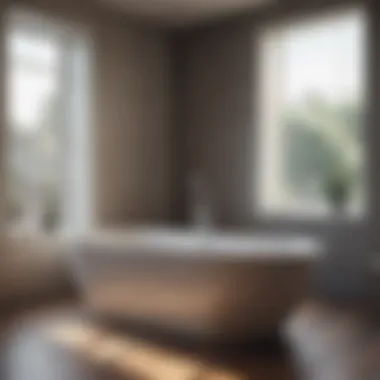
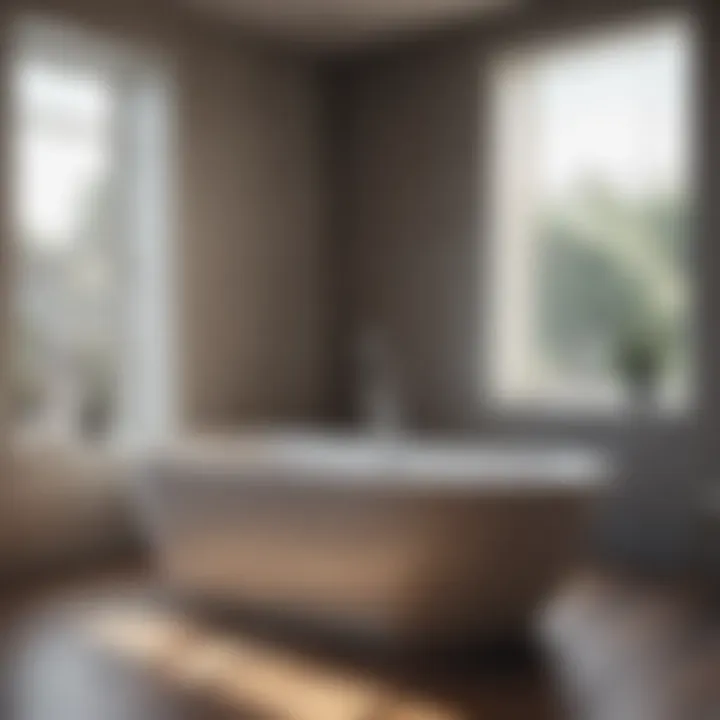
Intro
As we navigate through modern home design, one trend that's bubbling to the surface is the increasing popularity of walk-in bathtubs. Not only do they provide an appealing aesthetic, but they also cater to a burgeoning demand for accessibility and safety in the bath space. More homeowners are prioritizing their bathing experience, pushing the boundaries of traditional bathroom design. This section will outline important aspects regarding these bathtubs, which marry function with style and safety.
Instead of just seeking a place to wash away the day’s stress, many are crafting their bathrooms into serene sanctuaries where comfort dominates. It’s about embracing a lifestyle that invites relaxation while ensuring that all family members—young and old—can enjoy it effortlessly. This article will delve into the current trends surrounding walk-in bathtubs, the array of styles available, and the visual ideas that can transform your space into a restorative haven.
Foreword to Walk-in Bathtubs
The concept of walk-in bathtubs finds itself at the intersection of comfort, safety, and accessibility. Homeowners are increasingly looking for solutions that enable them to enjoy their bathing experience without the hassle that traditional bathtubs may present, especially when age or physical challenges come into play. Walk-in bathtubs effectively combine the functionality of a tub with features that promote ease of access. In this article, we will dive into what makes walk-in bathtubs so coveted among homeowners and the unique attributes that set them apart.
Defining the Walk-in Bathtub
A walk-in bathtub is simply a low-threshold bathing unit that allows users to easily enter and exit without needing to step over a high-sided tub. Typically, these bathtubs feature a watertight door that opens outward, allowing for seamless access. Many also come equipped with safety features, such as grab bars and slip-resistant surfaces. Unlike classic tubs, a walk-in version generally emphasizes not only comfort but also user-friendly design — a crucial consideration when catering to a diverse audience.
Some might wonder how such a simple alteration could hold significance. Yet, the ease of entry can make a world of difference for seniors or those with mobility issues. With a walk-in bathtub, the fear of falls or accidents is greatly diminished, contributing to a more relaxed and enjoyable experience.
Historical Context
The origin of the walk-in bathtub can be traced back a few decades, correlating with the growing awareness of safety and accessibility in home design. The shift began when society began to prioritize the needs of an aging population. Older homes, which often have traditional bathtubs, didn't account for the unique challenges that come with aging bodies. As a result, the demand for safer bathing options emerged out of a desire to adapt living spaces to better suit the physical realities many individuals face as they age.
In the 1980s, various companies began experimenting with designs and manufacturing options that would cater specifically to this demographic. As technology advanced, so too did the design and functionality of walk-in bathtubs. Fast forward to today, and these bathtubs can now be found in countless homes across the nation, showcasing advanced safety features and elegant designs. This evolution signifies a broader cultural shift towards valuing inclusivity and practicality in home improvement, reflecting societal changes that recognize the need for accessible living.
Overall, the journey from convenience to necessity for walk-in bathtubs is quite telling. They not only represent a trend in home design but also a deeper understanding of the lifestyle needs of homeowners. Better yet, they symbolize a commitment to maintaining dignity and independence as we age, which is perhaps the most valuable aspect of this modern bathing solution.
The Popularity Surge
In recent years, walk-in bathtubs have seen an unmistakable upswing in their popularity. This surge is not merely a passing trend; it is a reflection of changing consumer behaviors and increased awareness about home accessibility and comfort. Today, they appeal not just to the elderly but also a wide array of homeowners looking to enhance their bathing experience with a touch of luxury and practicality. The importance of this section lies in uncovering the latest demographics and market trends that drive this boom in walk-in bathtub adoption.
Demographic Shifts
Demographic changes deeply influence the rise of walk-in bathtubs. As the population ages—particularly the Baby Boomer generation—there’s a growing need for home modifications that prioritize safety and ease of use. Many young families are also gravitating towards these bathtubs for reasons that stretch beyond age-related functionality. For instance, parents of small children appreciate the accessibility features that make bath time safer.
Moreover, younger homeowners tend to favor designs that blend style with modern safety features. They see these bathtubs as an opportunity to invest in their homes' long-term value while also providing a spa-like atmosphere. This shift indicates that walk-in bathtubs are not a niche product but rather a versatile solution that fits into diverse lifestyles.
Market Trends and Data
The data surrounding walk-in bathtubs paints a compelling picture of their increasing market traction. According to recent reports, the walk-in bathtub market is projected to grow significantly over the next few years. A few contributing factors include:
- Safety and Accessibility Features: Many consumers regard safety as a major concern in their bathing experience. Features like low thresholds, non-slip surfaces, and grab bars contribute to the overall appeal of walk-in tubs.
- Health and Wellness Movement: There’s a noticeable trend towards self-care and wellness. Walk-in bathtubs, with their therapeutic soaking options, align perfectly with this ethos, appealing to those looking to create their own oasis at home.
- Innovative Designs: Manufacturers now offer a range of customizable options that appeal to design-conscious consumers. From modern finishes to various shapes, these bathtubs can complement various bathroom styles.
"The appeal of walk-in bathtubs reaches beyond age. They are redefining how people view personal wellness and at-home comfort."
As these trends continue to unfold, it is evident that the rising popularity of walk-in bathtubs goes hand in hand with a desire for improved accessibility and lifestyle enhancement in home environments.
Key Features of Walk-in Bathtubs
Walk-in bathtubs are not just a passing fad; they embody a blend of safety, comfort, and luxurious design that resonates with many homeowners. Understanding the pivotal key features of walk-in bathtubs helps to appreciate the value they bring to a home. Unlike traditional bathtubs, walk-in models address the pressing need for accessibility while also offering a touch of elegance. In this section, we’ll delve into the essential attributes that distinguish walk-in bathtubs, emphasizing how these features cater to both practical and aesthetic demands.
Accessibility and Safety
One of the standout benefits of walk-in bathtubs is their built-in accessibility features, which make bathing safer for a variety of users. Many individuals, particularly seniors or those with mobility challenges, find traditional bathtubs daunting and hazardous. With walk-in models, the low entry threshold is a game-changer.
Key elements include:
- Slip-resistant floors: These are crucial for preventing accidents when entering or exiting the tub.
- Grab bars: Strategically placed, they provide support and instill confidence in users as they navigate their bathing routine.
- Wide door openings: Unlike traditional tubs that often require a significant step over, walk-in bathtubs have doors that swing open, allowing easy access.
"Accessibility is not just a feature; it's a fundamental aspect of comfortable living. Walk-in tubs pave the way for independence."
Spa-Like Experiences
Another appealing feature is the ability to turn ordinary bath time into a therapeutic experience. Modern walk-in bathtubs often come equipped with jets that offer hydrotherapy benefits. This is not merely indulgent; hydrotherapy can aid in alleviating muscle tension, improving circulation, and enhancing overall relaxation.
Among the spa-like features you might find are:
- Adjustable water jets: Users can often modify the intensity and placement of jets to target specific areas of discomfort.
- Soaking options: Many tubs are designed for deep soaking, making it possible to fully immerse oneself in warm water.
- Chromotherapy: Some models incorporate colored lights to promote relaxation and balance mood through visual stimulation.
Customizable Options
Personalization is key when considering a walk-in bathtub. Homeowners want a product that fits seamlessly into their existing décor while meeting their specific needs. Thankfully, many manufacturers offer a variety of customizable features.
Some of the options include:
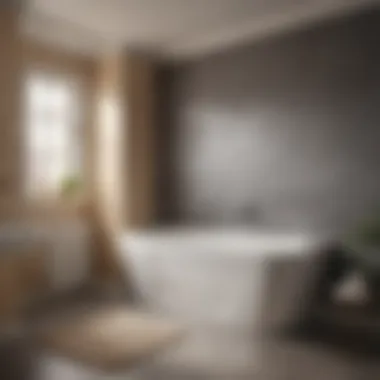
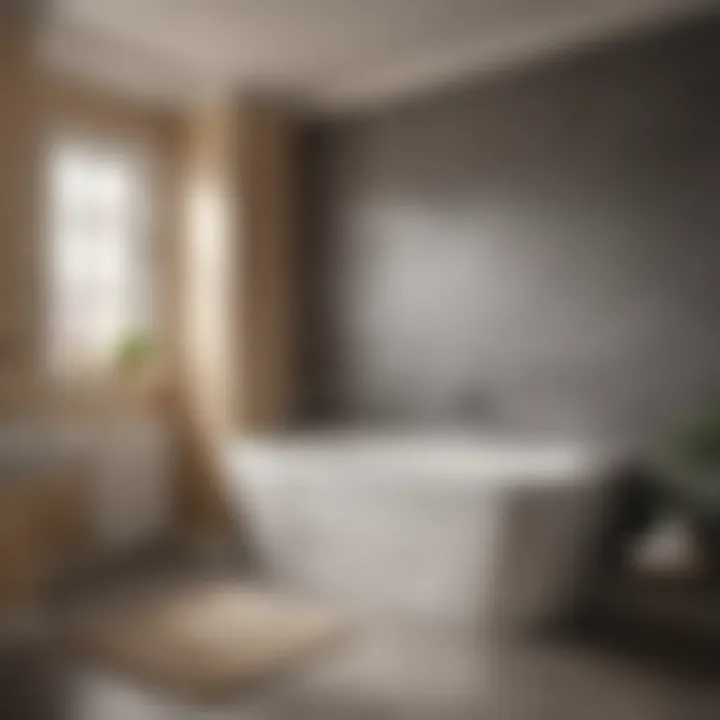
- Design and size: There’s flexibility in choosing the dimensions and aesthetic style to complement any bathroom space.
- Finish and materials: From acrylic to fiberglass and tile finishes, the choices can enhance the luxurious feel of the bathtub.
- Additional features: Options like heated seats, built-in lighting, or even music systems can be added to create a more personalized bathing experience.
Advantages of Walk-in Bathtubs
Understanding the numerous advantages of walk-in bathtubs is crucial for anyone considering this trend. These bathtubs aren't merely a fashion statement. Instead, they bring significant benefits in terms of health, safety, and property value. With a growing number of homeowners opting for these tubs, it's essential to unpack the reasons that make walk-in bathtubs such a popular choice.
Physical Benefits
Walk-in bathtubs are designed with accessibility in mind, significantly aiding those with mobility challenges. Older adults or individuals with disabilities find these tubs a game-changer, allowing them to bathe with greater ease. The low threshold of these tubs minimizes the risk of slips and falls, often associated with traditional bathtubs, which can have higher edges that require effort to step over.
Additionally, these tubs often feature built-in seating, ensuring users can sit comfortably while bathing. Hydrotherapy jets are another appealing feature, providing soothing massages that can relieve muscle tension and improve circulation. Thus, for those who battle chronic pain or stiffness, the tactile qualities of a walk-in tub can genuinely enhance their living quality.
"Accessibility in bathing isn't just a convenience; it's a crucial aspect of everyday life for many people."
Emotional Wellbeing
The emotional aspect of bathing often gets overlooked, yet it plays a pivotal role in our everyday lives. A walk-in bathtub can serve as a personal sanctuary where individuals escape the stresses of daily life.
Being able to indulge in a relaxing bath can lead to a boost in mental health. Walk-in bathtubs create an environment that encourages rest and relaxation, which can have positive effects on anxiety and overall mood. Furthermore, knowing that these bathtubs are designed for safety helps users feel more secure, decreasing anxiety about getting in and out of the tub. Ultimately, this ease of use can lead to a more serene bathing experience.
Increased Home Value
Investing in a walk-in bathtub can also be seen as an investment in your property's value. As bathrooms are one of the top areas potential buyers focus on during a home search, having a modern, well-equipped bathroom can elevate your home’s marketability.
Some homeowners have reported increased property value after installing a walk-in tub, particularly in markets where accessibility features are in demand. A stylish, safe bathing space can set your home apart, particularly for aging populations looking to buy a home tailored to their lifestyle needs.
In summary, for those contemplating the practicality of walk-in bathtubs, it becomes clear that the advantages extend beyond mere comfort. They encapsulate essential physical health benefits, contribute to emotional stability, and increase the long-term value of your home.
Design Considerations
When diving into the world of walk-in bathtubs, it becomes glaringly clear that design considerations are pivotal. These elements not only influence the aesthetics of your bathroom but also play a crucial role in how functionally accessible and safe these bathtubs can be for all users. Whether you aim for a stylish upgrade or a practical modification, every design aspect can impact your daily routine and overall happiness in the space. Choosing the right layout, materials, and style can transform your bathing area into a sanctuary that caters to both comfort and safety.
Space Planning and Layout
Creating an inviting space for a walk-in bathtub doesn't just hinge on picking out a stylish unit; it starts with thoughtful planning of the layout. First off, consider the available square footage. A walk-in tub might require more room than its standard counterpart, so measuring your space accurately is a must.
- Functional Flow: Ensure there's enough room to maneuver around the bathtub comfortably. The last thing you want is a cramped feel when trying to get in and out.
- Positioning: Placing the bathtub near essential amenities like grab bars can heighten safety. It’s important to think about how you plan to access the tub. Would it be convenient for a shower curtain, or is a glass door a better fit?
- Flexible Layouts: In small bathrooms, opting for a corner location can save space while still providing easy entry and exit points.
Take into account the plumbing and electrical lines as well; they can greatly affect your layout options. A well-thought-out design can transform not only how the bathroom looks, but also how effectively it serves its purpose.
Material and Finishes
Selecting materials and finishes for your walk-in bathtub is more than just about color. It’s about durability, maintenance, and personal style. Several options are out there, each catering to different tastes and needs.
- Fiberglass: This is lightweight and often more budget-friendly. It’s easy to install, making it ideal for quick renovations.
- Acrylic: Slightly thicker than fiberglass, it offers better insulation and is available in a broad range of colors.
- Porcelain and Ceramic: For a classic look, these choices are timeless but can be more expensive and prone to chipping.
Moreover, consider finishes that resist mold and scratches. Think about your lifestyle, too. If you have children or pets, you might want tougher materials that withstand wear and tear. Having the right finish can contribute significantly to the longevity of your bathtub as well as its visual appeal.
Complementing Existing Decor
Finally, when jumping into the design of your walk-in bathtub, considering how it complements your existing décor is imperative. A new tub should seamlessly blend into your home's aesthetic rather than clash with it. Plus, that integration can enhance the overall value of your property.
- Color Coordination: Ensure the color of the bathtub aligns with your current bathroom theme. If your walls are a deep navy, a stark white tub may not hit the mark.
- Style Choices: If the home theme is contemporary, opting for sleek, minimalist fixtures can keep the atmosphere cohesive. Or, for a vintage vibe, a clawfoot design might be ideal.
Choosing the right walk-in bathtub can harmonize functionality and beauty, making it an integral part of your home's sanctuary.
Through careful consideration of these design elements, you can have a walk-in bathtub that not only serves its purpose effectively but also enhances the space's beauty and functionality. In turn, this maximizes your enjoyment and satisfaction within your home.
Installation Process
The installation process of a walk-in bathtub stands as a vital aspect of the journey towards enhanced bathing experiences. This involves not only placing a tub into a bathroom but also ensuring that it blends seamlessly with the home while prioritizing accessibility and safety. A well-conducted installation can contribute significantly to the functionality and aesthetic appeal of a bathroom.
Hiring Professionals vs. DIY
When it comes to the installation of a walk-in bathtub, one must weigh the pros and cons of hiring professionals against the allure of do-it-yourself solutions. Here are some considerations:
- Expertise: Hiring professionals typically means engaging individuals who are well-versed in plumbing and electrical work. They understand the intricacies that are often overlooked by amateurs.
- Time Efficiency: A professional installation can be completed in a fraction of the time it would take for an inexperienced homeowner to do it themselves. The added time can often be a critical factor for busy households.
- Warranty Considerations: Many manufacturers require that installations are conducted by licensed professionals to maintain warranties. This can save a homeowner headaches down the line if issues arise.
On the flip side, DIY installations have their appeal:
- Cost Savings: Without the labor cost of professionals, a DIY installation might seem like a more budget-friendly option. However, this could lead to unforeseen expenses if mistakes occur.
- Personal Satisfaction: Some homeowners find value in completing a project on their own. There’s a strong sense of accomplishment that comes with constructing a significant element of your home.
While both options have merits, a cautious approach suggests that for complex installations such as a walk-in bathtub, hiring a professional might be the safer route.


Cost Factors and Budgeting
Understanding the cost factors involved in walk-in bathtub installation is crucial for homeowners. To put it plainly, budgeting should go beyond just the price of the bathtub itself.
- Bathtub Cost: Prices can vary widely, ranging from basic models at around $2,000 to high-end tubs exceeding $10,000, depending on features and materials.
- Additional Modifications:
- Permitting: Some locales require permits for bathroom remodels, including tub installations. Check with your local authorities to avoid fines or delays.
- Installation Costs: Labor costs will vary by region but generally add several hundred to a couple of thousand dollars to the total. Ensure you get quotes from multiple contractors.
- Plumbing Adjustments: Depending on the layout, adjustments may be necessary to accommodate the new tub. This can include rerouting pipes or even reinforcing the floor to support the bathtub’s weight.
- Electrical Work: If your tub has additional features like hydrotherapy jets or lights, you might also need an electrician involved, which adds to the overall cost.
In summary, while setting a budget, it's important to factor in not just the cost of the tub, but also all associated expenses that come with installation. This detailed understanding helps ensure you're financially prepared for the journey to enjoying your new walk-in bathtub.
Proper planning and budgeting will ensure a smoother installation process, avoiding unnecessary surprises along the way.
Maintenance and Care
Maintaining a walk-in bathtub is a crucial aspect not just for its longevity, but for ensuring safety and hygiene. As you dive into this bathing experience, you want it to remain as inviting and functional as the first day it was installed. Walk-in bathtubs can be a bit more complex than standard tubs, which is why understanding maintenance and care is essential. These tubs are not just about comfort; they need your attention to keep their features working properly and to prevent any mishaps that could arise from neglect. Here’s how you can best care for your bathtub.
Cleaning Recommendations
Keeping your walk-in bathtub clean is more than just aesthetics; it also affects the longevity of the materials and your personal health. Regular cleaning helps in preventing mold, mildew, and soap scum, which can accumulate in places that might be a bit harder to reach.
- Daily Wipe Down: A quick rinse with hot water after every use can help eliminate residues. Use a soft sponge or cloth for this purpose to avoid scratching the surface.
- Gentle Cleaners: Opt for non-abrasive cleaners specifically designed for acrylic or fiberglass finishes. A simple solution of vinegar and water can do wonders. Avoid harsh chemicals as they can break down the material over time.
- Grout and Seals: Pay special attention to the areas around the tub where grout and seals are present. Scrub these areas with a soft brush to keep them free of buildup.
- Deep Cleaning: Set aside time every few weeks for a thorough cleaning. Using a mixture of baking soda and water can help tackle any stubborn stains. Let it sit for a while before scrubbing and rinsing.
"A clean bathtub isn’t just about looks; it’s about maintaining a sanctuary in your home where you can relax spellbound and at ease!"
Regular Maintenance Checklist
In addition to cleaning, performing periodic maintenance checks can keep everything in good working order. Below is a simple checklist that can guide you in maintaining your walk-in bathtub:
- Check for Leaks: Regularly inspect the plumbing fixtures for any signs of leaks or drips. Address any issues immediately to avoid water damage.
- Inspect the Walk-in Feature: Ensure that the door seal is tight and functioning correctly. Moisture can seep through any cracks, leading to mold growth.
- Evaluate the Water Jets (if applicable): If your walk-in bathtub has jets for hydrotherapy, check that there are no obstructions and that they are functioning properly. Cleaning the jets routinely will help prevent any buildup.
- Examine the Drainage: Ensure that the drainage system is free from hair and debris to avoid clogs. A once-a-month check can save you from a bigger hassle down the line.
- Surface Protection: Consider applying a protective coat on your tub to enhance its durability and shine. Check with the manufacturer for recommendations on the right product.
By incorporating these practices into your routine, you can help maintain not just your installation but the charm and luxury of your bathing haven for many years to come. Effective maintenance and care keep your walk-in bathtub a safe and comfortable retreat.
Common Misconceptions
The topic of common misconceptions surrounding walk-in bathtubs is crucial to understand for potential buyers. Much like any product that gains traction, walk-in bathtubs face myths and misunderstandings that can lead to misinformed decisions. In this section, we will debunk two widely held beliefs about these bathing fixtures, focusing on their perceived expense and their alleged exclusivity to the elderly. Addressing these misconceptions not only educates homeowners, but also highlights the versatility walk-in bathtubs can bring to a variety of households and lifestyles.
Expensive and Luxurious Only
A prevalent belief is that walk-in bathtubs are solely for the affluent, painting them with a broad brush of luxury and high costs. While there are indeed high-end models with price tags that might make one gulp, they are not the only option on the table. Many manufacturers today produce a range of products catering to various budgets. This includes affordable versions that retain essential features such as safety elements, without the posh aesthetics.
It's essential to weigh costs against benefits. For instance, the initial spending can often be outweighed by ongoing factors like reduced healthcare expenses for falls or accidents. Homeowners investing in these bathtubs may find themselves lowering their overall living costs by avoiding future medical bills arising from injuries in traditional tubs. Remember, a sizable upfront cost can translate into long-term savings and peace of mind.
Moreover, with features such as grab bars, slip-resistant flooring, and low thresholds, walk-in bathtubs can be invaluable for everyone— not just those with an eye for high luxury.
"Investing in a walk-in bathtub is not just about lavish comfort; it's a step towards safety for everyone in the home."
Only for the Elderly
Another common myth is that these bathtubs are exclusively for elderly users or individuals with physical challenges. This misconception could not be further from the truth. While many elderly individuals benefit greatly from the safety features, this does not mean that younger generations cannot take advantage of them just as well.
Younger homeowners increasingly recognize the value of convenience and safety. Many people who opt for walk-in bathtubs are simply looking for a way to luxuriate in their bathing experience without the stress of slipping or straining. Families with young children or those who enjoy relaxing baths at the end of a long day see these tubs as useful additions to their homes.
In fact, many modern walk-in tubs include features for all ages, such as built-in seats and therapeutic massage options, promoting relaxation. Therefore, dismissing these fixtures as merely “old folks’ tubs” is shortsighted and undermines the broad appeal they hold.
In summary, dispelling these common misconceptions is vital for potential buyers. Understanding that walk-in bathtubs can be both cost-effective and suitable for a broader demographic can help homeowners make informed choices that enhance their bathing experiences, regardless of age.
Comparative Analysis
When diving into the walk-in bathtub discussion, it's crucial to assess it against traditional options: standard bathtubs and showers. This comparative analysis sheds light on various elements that can sway a homeowner's decision, emphasizing benefits and considerations that are unique to each choice.
Walk-in Bathtubs vs. Standard Bathtubs
Walk-in bathtubs distinguish themselves from standard tubs in more ways than one, primarily regarding accessibility. For individuals dealing with mobility issues or the elderly, the traditional high-sided tub can pose a significant risk. In contrast, walk-in bathtubs offer lower thresholds, allowing users to step directly into the tub without needing to lift their legs over a barrier. This feature alone can drastically reduce the chances of slips and falls, which is an aspect that really resonates with homeowners prioritizing safety.
Aside from safety, walk-in bathtubs present a world of options with built-in features that cater to comfort and relaxation. Jet options, for example, transform a bath into a miniature spa experience, offering therapeutic benefits often missing from standard tubs. Homeowners often find the ergonomic designs of walk-in tubs more inviting, as they often include seating and specialized back support to encourage lounging and unwinding.
"Walk-in bathtubs are not just a product; they are a step toward independence for many users."
However, there are some practical considerations as well. Walk-in bathtubs typically require more space and can be pricier than standard tubs. For homeowners with tighter budgets or limited bathroom sizes, this might pose a challenge. The installation process is also different, often needing professional assistance and possibly significant remodeling work to fit the structure properly.
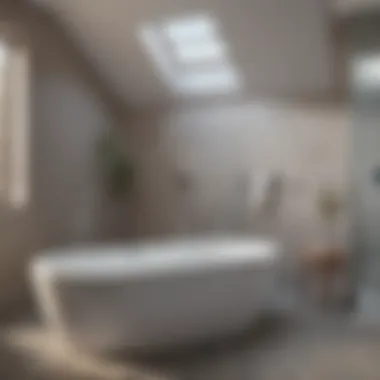
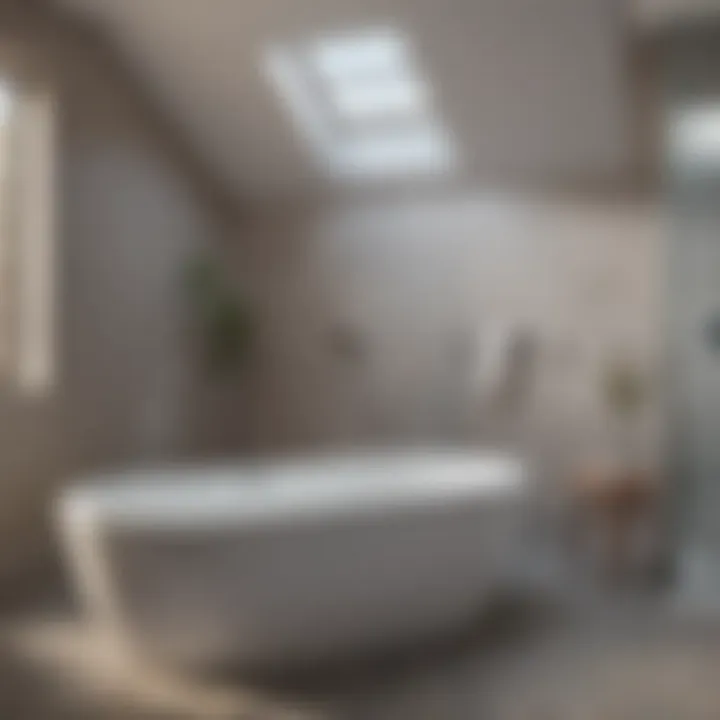
Walk-in Bathtubs vs. Showers
Comparing walk-in bathtubs to showers brings an interesting perspective to light. On the one hand, showers are often revered for their practicality, primarily for quick clean-ups rather than long, leisurely soaks. In today’s fast-paced world, many opt for the efficiency of a shower. Yet, it's worth noting that the walk-in bathtub does offer some enhanced features that can charm the busy homeowner.
For starters, a walk-in bathtub allows for a versatile bathing experience. Individuals can enjoy the comforts of a full bath while still having the convenience of easy access. Additionally, for those managing chronic pain or stress, soaking in a warm bath can be therapeutic, which a shower may not provide. The option of having a combination unit—one that includes both a walk-in bathtub and a shower—could also be beneficial, striking a balance between practicality and indulgence.
Security is another crucial difference. Many modern showers may lack the safety features embedded in walk-in tubs, such as grab bars and slip-resistant surfaces. In particular, those with mobility issues find walk-in bathtubs to be a safer option compared to standard showers, which might not offer such guarantees.
In the end, the choice between a walk-in bathtub, a standard tub, and a shower often hinges on individual needs and lifestyle preferences. Each option comes with its own set of benefits that can cater to different audiences, starting from safety, accessibility to personal comfort, and therapeutic benefits.
Case Studies and Real-life Experiences
Exploring real-life case studies and experiences provides invaluable insight into the walk-in bathtub trend. Real-world scenarios give a practical perspective, illustrating not just the advantages but also the challenges homeowners face with this increasingly popular fixture. These examples shed light on personal transformations, acceptance of the products, and even the emotional ramifications of integrating a walk-in bathtub into one’s home.
Homeowner Testimonials
Homeowner testimonials are a crucial component when understanding the impact of walk-in bathtubs. They serve as a direct line to personal experiences. For many individuals, a walk-in bathtub represents more than a bathroom upgrade; it symbolizes increased independence and an improvement in everyday life.
One homeowner, Mary, opted for a walk-in tub after her husband's surgery. She noted, "It was a game changer. He used to struggle with everyday activities, but now he can bathe without worrying about slips or falls. It’s given him back some dignity and independence."
Another homeowner, Robert, shared his enthusiasm saying, "I thought it was just for the elderly, but I discovered the spa features are so relaxing. We use it regularly after long days. It’s like having a personal wellness retreat in our home!"
These testimonials reveal a mixture of practical benefits and emotional comfort. Their stories underscore the versatility and appeal of walk-in bathtubs beyond mere functionality.
Before-and-After Transformations
Before-and-after transformations paint a vivid picture of the impact of walk-in bathtubs on the home environment. They not only showcase aesthetic changes but also underline how these fixtures can enhance usability and safety.
Take the example of a couple living in a modest bungalow. Initially, their traditional bathtub was cramped and posed a safety risk. After installing a walk-in tub, the husband remarked on the vast improvement in both space and accessibility. The installation came with grab bars and a non-slip surface, dramatically increasing their safety during bath times. The after photos revealed a stylish, serene environment that replaced the cramped, somewhat outdated look.
The Visual Impact
On a visual level, the transformation of a bathroom space with a walk-in bathtub can be nothing short of stunning. Consider the case of a homeowner who redesigned their entire bathroom around their new tub.
"The moment I stepped into the renovated bathroom, I felt my stress evaporate. Adding a walk-in bathtub turned a dreary space into a beautiful sanctuary. It’s not just about safety, it’s about creating an oasis.”
This highlights how a thoughtfully chosen walk-in bathtub not only meets functional needs but can also elevate the overall design of a bathroom, integrating style and purpose seamlessly.
In summary, incorporating case studies and real-life testimonials provide a rich narrative of the walk-in bathtub experience, revealing deep insights that mere statistics cannot convey. These accounts encourage potential buyers to envision their own transformation, rallying behind the idea that a small change can lead to significantly uplifting outcomes.
Future Outlook
Understanding the future outlook for walk-in bathtubs is essential for homeowners and industry professionals alike. With the growing recognition of the need for accessibility and safety in the bathroom, the trend toward walk-in bathtubs shows no sign of slowing down.
Emerging Trends
Several emerging trends indicate how the market for walk-in bathtubs is evolving. Firstly, an increasing number of younger homeowners are gravitating towards these features, previously viewed as exclusively for the elderly. Many now appreciate the convenience and luxury provided by walk-in designs.
- Sustainability: Eco-friendly materials and water-saving designs are gaining some traction. Homeowners are more aware of their carbon footprint and are looking for fixtures that are both stylish and environmentally responsible.
- Aesthetic Appeal: Walk-in bathtubs are no longer plain and utilitarian. Manufacturers are crafting stunning models that can fit seamlessly into any bathroom decor, appealing to a broader audience.
- Combination Units: The rise of space-saving combination bathtub and shower units is notable. These designs cater to individuals who seek the comfort of a bath without sacrificing the practicality of a shower, appealing to families and busy professionals.
These trends highlight a significant shift towards personalization and innovation, which can greatly enhance overall home experience.
Technological Innovations
Technology is playing an increasingly influential role in the development of walk-in bathtubs. Several innovations are shaping the future of these bathing spaces.
- Smart Features: Many models now come equipped with smart technology. This allows users to control water temperature and flow through a smartphone app or voice commands.
- Hydrotherapy Options: Integration of hydrotherapy systems promotes relaxation and pain relief, making these bathtubs more appealing for health-conscious individuals.
- Safety Enhancements: Innovations such as slip-resistant surfaces, built-in grab bars, and adjustable seating make walk-in bathtubs safer for users of all ages. These enhancements are a prime consideration for families and older adults.
Keeping an eye on these trends and technological advancements not only prepares you for better decision-making but also ensures that you can elevate your home's ambiance and functionality with modern bathing solutions.
"Walk-in bathtubs are evolving far beyond a simple bathing option; they embody safety, luxury, and style—especially noticeable in upcoming designs."
Through understanding these elements, homeowners can see the walk-in bathtub trend as more than a passing phase. It signifies a commitment to accessibility, comfort, and innovation in modern living.
Summary and The End
In wrapping up our exploration of walk-in bathtubs, it is crucial to acknowledge the myriad reasons why this trend has gained traction in modern homes. The shift towards prioritizing accessibility and safety in bathrooms reflects broader societal changes regarding aging in place and accommodating diverse physical needs. From busy households to individuals seeking a sanctuary of relaxation, walk-in bathtubs cater to a wide audience.
Recap of Key Points
- Accessibility: Walk-in bathtubs bring an ease of entry that is paramount for elderly or mobility-challenged individuals. Many designs feature low thresholds and built-in seating, making it simpler for everyone to enjoy a soak without the risk of slipping.
- Safety Features: Safety is a top concern, and walk-in bathtubs often come with non-slip floors, grab bars, and anti-scald devices. These features not only prevent accidents but also instill confidence in home users.
- Aesthetic Appeal: Beyond functionality, these bathtubs offer various styles and finishes. Homeowners can select options that align with their personal taste, blending practicality with beauty in their bathing spaces.
- Health Benefits: Soaking in warm water can alleviate muscle tension and improve circulation, benefiting physical health as people engage with these bathtubs for relaxation or therapeutic purposes.
- Resale Value: Investing in a walk-in bathtub can enhance property value. Such additions often boost buyer interest, particularly among families looking for longevity in their homes.
"Walk-in bathtubs exemplify the crossroads where luxury meets necessity, turning an everyday routine into a delightful experience."
Final Thoughts on the Trend
As we conclude, the future of walk-in bathtubs looks promising. The increasing demand for home modifications that align with modern living and accessibility needs suggests that these fixtures are more than just a passing fad. As technology progresses, we anticipate innovations that will revolutionize the features of walk-in bathtubs, perhaps even incorporating smart technology for an enhanced user experience.
Moreover, the dialogue around wellness and self-care continues to rise, making walk-in bathtubs an essential component of home bathrooms. As such, when considering renovations or upgrades, house owners should regard walk-in bathtubs not just as plumbing fixtures, but as integral elements that reflect an evolving narrative of comfort, safety, and style in their homes.



